Students Experience the Rocky Mountains and Southwest Together
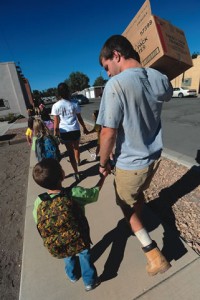
Colorado College senior and New Student Orientation leader Buck McKenna holds the hand of a young boy from La Puente as the walk to a park in Alamosa, Colo., to paint. Photos by Christian Murdock.
Elizabeth Pudder and Steve Crosby are Colorado College’s Joint Chiefs of Staff when it comes to CC’s New Student Orientation, known on campus as the Priddy Experience.
The two are responsible for putting together a field expedition that rivals the military’s for detailed logistics. Consider: a five-day trip consisting of 60 teams going to 50 sites scattered throughout three states, involving 700 people — many with special dietary restrictions.
Pudder, service coordinator for the Center for Service and Learning, oversees 39 urban and “frontcountry” trips; Crosby, CC’s outdoor education director, oversees 21 backcountry trips. All of the Priddy Experience trips are led by CC student volunteers or recent alumni, with at least two leaders per trip — and more than 100 students on the wait list to lead a trip.
This year Colorado College sent 597 students, which included first-year, transfer, international exchange, and international students, and 122 student leaders on a wide range of New Student Orientation trips, all of which included a service component. Students did everything from working in animal shelters, nursing homes, and schools, to volunteering in art museums, working on organic farms, and conducting campsite inventories.
“Most of the trips, whether they are urban, frontcountry, or backcountry, are three to six hours away,” Pudder says. “We want new students to experience the region.” Each group usually consists of nine to 12 students, which allows them to get to know one another away from the residence halls and classrooms.
The off-campus aspect of the Priddy Experience is huge, says Kasi Carter ’11, a drama major who has led five trips to five different sites, including three fall Priddy Experiences, one Winter Start trip, and one trip geared for athletes who arrive on campus earlier than other students.
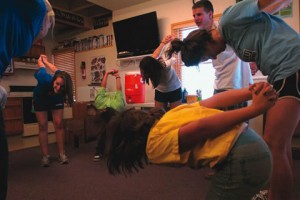 There is a noticeable difference in the students from when they depart on their trip and when they return, Carter says. “When they go through on-campus orientation and are getting to know each other, they maintain a very careful demeanor. They’re careful about what they say, how they act, what they wear. But then we go off-campus, to places with no showers; they can’t worry about how they look or their clothes. People lose their inhibitions. They realize people like them for who they are. They come back to campus and they are strutting. They know they’re awesome.”
There is a noticeable difference in the students from when they depart on their trip and when they return, Carter says. “When they go through on-campus orientation and are getting to know each other, they maintain a very careful demeanor. They’re careful about what they say, how they act, what they wear. But then we go off-campus, to places with no showers; they can’t worry about how they look or their clothes. People lose their inhibitions. They realize people like them for who they are. They come back to campus and they are strutting. They know they’re awesome.”
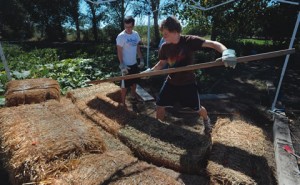 The service aspect of the trips is also important. Not only is it an excellent group- and team-building forum, but it also underscores CC’s strong service ethic. Since the program began, 84 percent of CC students have gone on to volunteer through the Center for Service and Learning, Pudder says. “We have students on the New Student Orientation trip who are back in the office the following week, asking how they can volunteer,” says Carter, who has interned in the office.
The service aspect of the trips is also important. Not only is it an excellent group- and team-building forum, but it also underscores CC’s strong service ethic. Since the program began, 84 percent of CC students have gone on to volunteer through the Center for Service and Learning, Pudder says. “We have students on the New Student Orientation trip who are back in the office the following week, asking how they can volunteer,” says Carter, who has interned in the office.
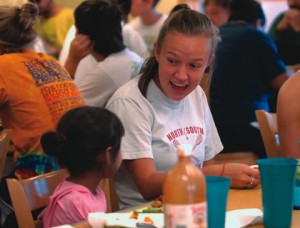 Another component of the Priddy Experience trips is a group discussion and reflection each evening. Topics include academics at CC; diversity, culture and stereotypes; and drugs, sex, and alcohol. “It’s really neat to think that there are 700 CC people sharing and seriously discussing the same topic each night,” Pudder says.
Another component of the Priddy Experience trips is a group discussion and reflection each evening. Topics include academics at CC; diversity, culture and stereotypes; and drugs, sex, and alcohol. “It’s really neat to think that there are 700 CC people sharing and seriously discussing the same topic each night,” Pudder says.
The fact that all trips are student-led, with no adult chaperones, makes for open conversation, Carter says. “After a bit, the new students really open up and ask the questions that are important to them.” She says many of the questions are about the social aspects of college life, with the students’ underlying concern being “Will I fit in?”
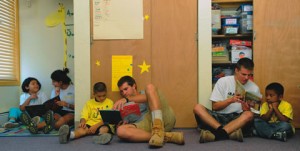 Evidence shows that the program does ease students’ concerns, and helps them make friends and adjust to CC. From 2000 to 2002, 8.5 percent of first-year students left CC; since the Priddy Experience trips began, that number has dropped to 4.4 percent, Pudder says.
Evidence shows that the program does ease students’ concerns, and helps them make friends and adjust to CC. From 2000 to 2002, 8.5 percent of first-year students left CC; since the Priddy Experience trips began, that number has dropped to 4.4 percent, Pudder says.
This is the eighth year that Colorado College has undertaken the massive effort. The Priddy Experience began in 2003 as the result of a $7.9 million grant the previous year from the Robert & Ruby Priddy Charitable Trust. The grant was one of the largest in CC’s history and required that the school match the funds by 2010. The money was spread across various campus programs, with $125,000 designated to NSO trips, which CC pledged to sustain.
Among the expeditions Pudder oversees are trips to eight sites that have hosted Priddy Experience students every year since the program was initiated: the Center for Contemporary Arts, Comanche National Grasslands, Koshare Indian Museum, La Puente Home, Mission Wolf, Santa Fe Children’s Museum, Santa Fe Habitat for Humanity, and St. Elizabeth’s Shelter.
Crosby has worked with the U.S. Forest Service, Rocky Mountain Field Institute, and Colorado 14ers Initiative to develop the backcountry trips, where students typically do trail work and maintenance and campsite rehabilitation. This year 10 groups collected data for a campsite inventory in the Collegiate Peaks Wilderness, Crosby said.
Behind the Scenes: Trip Preparation Can be Less Than Pretty
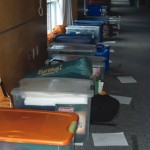 The behind-the-scenes preparation for the Priddy Experience trips that have fanned out across the Southwest for the past eight years is massive. There are spreadsheets, binders, and maps. There are student information forms, emergency procedures, and medical histories. There is bug spray, sunscreen, and hand sanitizer.
The behind-the-scenes preparation for the Priddy Experience trips that have fanned out across the Southwest for the past eight years is massive. There are spreadsheets, binders, and maps. There are student information forms, emergency procedures, and medical histories. There is bug spray, sunscreen, and hand sanitizer.
Organization is crucial, says Elizabeth Pudder, service coordinator for the Center for Service nd Learning.
“It’s all about organization,” says Derek Hanson, director of retail operations for Bon Appetit, CC’s food service provider, which packs all the food necessary for the Priddy Experience trips. The food is ordered six weeks in advance, then sorted, divided, and boxed, the non-perishables first, says Mike Kepler, the manager of Benji’s.
“Snickers bars are essential,” says Hanson. This year 2,300 Snickers bars went out on Priddy Experience trips. So did 3,080 bagels, 90 pounds of cream cheese, 2,300 tortillas, 145 pounds of couscous, and 2,210 apples — red and green. Food accounts for $55,000 of the $150,000 budget, with insurance and transportation being the other high-ticket items.
Slocum Commons and Bemis Hall are the major staging areas prior to departure: The gear is stored in Slocum and the food in Bemis.
All necessary gear such as tents and stoves is checked prior to departure to be sure it is in working order. Gear is assigned to each trip, and arranged in Slocum Commons in order of trip departure.
Food for the nearly 700 participants is organized by trip and stored in Bemis Hall. Kepler says there are always last-minute changes to the already packed food boxes because of students’ food allergies and dietary restrictions.
Buses, vans, and trip routes must be arranged, with trips heading to the same region sharing a bus to help reduce CC’s carbon footprint. Trips have staggered departures times and places to ensure a smooth exodus. “It’s a lot of work,” Pudder says. “But it’s worth it.”
2010 Priddy Experience by the Numbers
- 597 students
- 122 student leaders
- 9 recent graduate leaders
- 39 frontcountry and urban trips
- 21 backcountry trips
- At least two leaders per trip
- 100+ students on wait list to lead a trip
- 75 tents utilized
- 3,000 hours of planning over three months
- 3,080 pita pockets
- 240 pounds of cheese
- 145 pounds of couscous
- $50,000 for food
- 36 questions on the Priddy Experience registration questionnaire (Our favorite: Is the only time you have been above 10,000 feet in altitude when you were in an airplane?)
- 61 vans, buses, and SUVs for transportation
- 11,648 total hours of volunteer service in two days
- 3,696 hours of backcountry service
- 84 percent of CC students do volunteer work before graduating
- Eight sites participating for all eight years
- $150,000 total cost
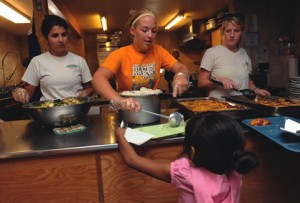
One Response to Priddy Trips Transform New Students, Inspiring Service to Others
[…] The Colorado College mission, “to provide the finest liberal arts education in the country,” becomes fulfilled in myriad ways both inside and outside the classroom, by professors and non-professors alike. Within days of arrival on campus, first-year students embark on an introductory “disentanglement” of sorts that takes them far out of their comfort zones and immerses them in service to others. (Read about the New Student Orientation program.) […]
Comments are closed.